Exploring the Allure of Round Pave Engagement Rings
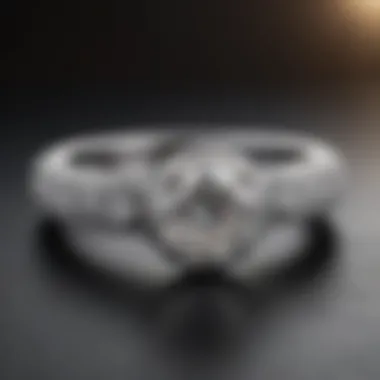
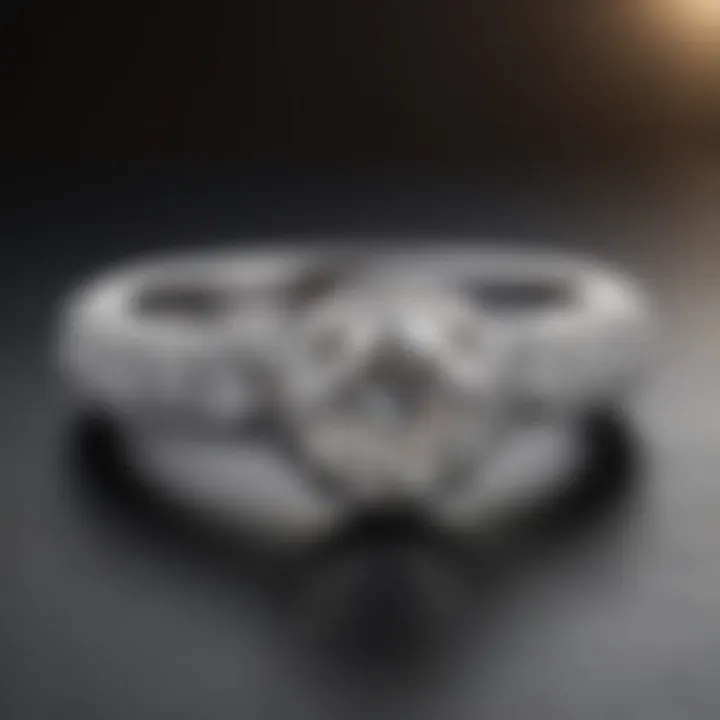
Intro
Round pave engagement rings are a stunning blend of glimmer and craftsmanship. They are often sought after by those who appreciate intricate details and a bit of sparkle in their symbols of love. This ring style stands out due to its unique setting of smaller diamonds, creating a continuous shimmer that catches the eye from every angle. As we dive deeper into this article, we will take a closer look at various elements that define these elegant pieces, providing insights for both the curious admirer and the thoughtful buyer.
Gemstone Overview
Definition and Characteristics
Pave, pronounced ‘pah-vay’, refers to a specific method of setting stones where tiny diamonds are set closely together in a way that minimizes the visibility of the underlying metal. This technique gives the impression that the ring is entirely paved with diamonds, creating a cohesive and luxurious appearance. The main characteristic of a round pave engagement ring is, of course, its central round diamond flanked by a sea of smaller stones.
Important characteristics of round pave rings include the following:
- Brilliance: The countless small diamonds together give off a mesmerizing sparkle, enhancing the overall allure of the ring.
- Versatility: They can match various styles, from modern to vintage, making it easy to find one that suits personal taste.
- Value: Pave settings can offer an impression of more diamonds, making the ring appear larger and more opulent without the price tag of a larger center stone.
Classification of Gemstones
In the context of round pave engagement rings, it’s vital to understand the different types of diamonds utilized. While most pave engagements prominently feature diamonds, there are alternative gemstones popular in jewelry as well. Here's a breakdown:
- Natural Diamonds: These are mined from the earth and come with various qualities dictated by the Four Cs: Cut, Color, Clarity, and Carat weight.
- Lab-Grown Diamonds: These have the same physical, chemical, and optical properties as natural diamonds but are created under controlled conditions in laboratories.
- Alternative Gemstones: Options like sapphires and rubies are sometimes used in pave settings, offering a unique twist on traditional rings, appealing to those seeking something different.
Historical Significance
Ancient Uses and Cultural Importance
The significance of gemstones in human history stretches back millennia. Across various cultures, gemstones have been revered for their beauty, believed powers, and representation of enduring love. The allure of diamonds in particular has transcended time. In ancient India, diamonds were believed to have protective qualities and were often worn by warriors. Meanwhile, in the Western world, diamonds became a symbol of commitment and love, leading to their key role in engagement rings.
"Gemstones have been entwined with love and power throughout history, illustrating the value society places on these precious items."
Myths and Legends Surrounding Gemstones
Throughout different eras and societies, gemstones have been wrapped in various tales and folklore. For instance, many believe that wearing a diamond helps to shield the wearer from harm. The idea of diamonds as a conduit of love was popularized in the 15th century through many romantic stories and poems. The round pave engagement ring, with its multitude of diamonds, symbolizes unity, harmony, and the dream of a lifetime spent together. Specific legends often attribute metaphysical properties to certain stones, reinforcing their worthiness as tokens of eternity.
Understanding both the historical backdrop and the classification of gemstones in round pave engagement rings not only enriches our knowledge but deepens our appreciation for these stunning pieces of jewelry.
As we navigate through the following sections, we will explore more facets of these enchanting rings, including their modern relevance, design choices, and tips for choosing the perfect one.
Prologue to Round Pave Engagement Rings
When it comes to love, many seek to symbolize their commitment with something that reflects not only their tastes but also the essence of their relationship. Round pave engagement rings have become a popular choice among couples, combining beauty and intricacy in a single piece.
The importance of exploring this topic lies in the unique features that distinguish pave settings. While many might be familiar with solitaire rings or three-stone settings, round pave rings possess a special charm. Their design integrates smaller diamonds set closely together—often in a way that gives an appearance of a continuous diamond surface. This technique not only enhances sparkle but also creates a striking visual effect that captures light in a captivating manner.
Benefits of opting for a round pave engagement ring include:
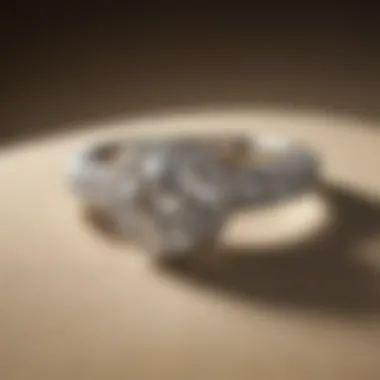
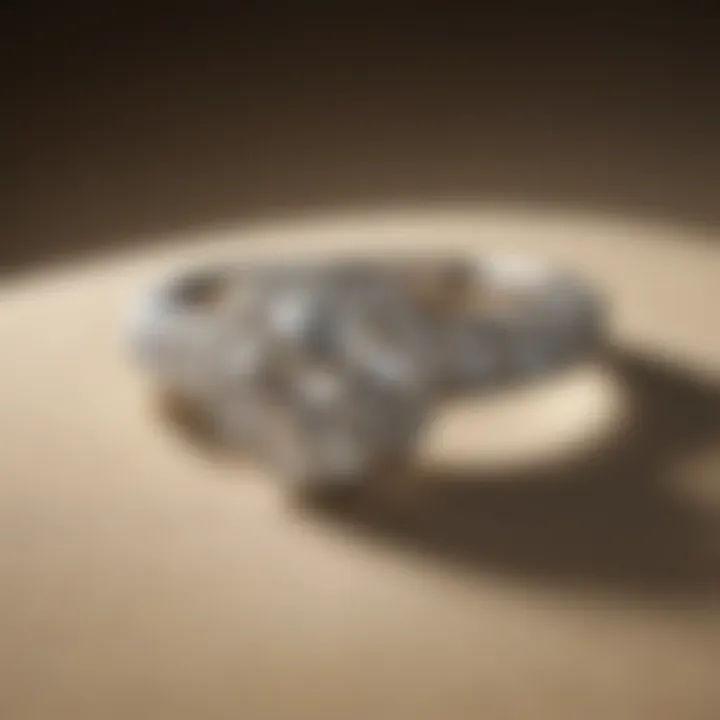
- Enhanced Brilliance: The pave setting's closely packed diamonds maximize reflections of light, making the overall piece dazzle brilliantly.
- Versatile Style: Round pave engagement rings can be easily paired with various styles, making them suitable for everyday wear or formal occasions.
- Artistic Creativity: Jewelers have the freedom to experiment with the pave technique, allowing for custom designs that can represent individual love stories.
However, buyers should consider a few factors. Understanding the quality of the pave setting is essential. The way diamonds are set can influence not just the aesthetic appeal but also durability. Additionally, the type of metal used in the band can affect the overall look and weight of the ring.
In this exploration, we will take an in-depth look at the features, designs, and considerations that surround round pave engagement rings, guiding future buyers in making informed choices about these enchanting symbols of love. Let's begin by discussing what a pave setting truly is.
Historical Perspective
Understanding the historical context of round pave engagement rings enriches our appreciation for these exquisite pieces. History serves as a lens through which we can appreciate the evolution of design, cultural influence, and the significance attached to engagement rings over time. This narrative unfolds not only the artistry involved but highlights the societal changes that shaped how we perceive love and commitment through jewelry.
Evolution of Engagement Rings
The concept of engagement rings dates back thousands of years. The ancient Egyptians were among the first to exchange rings, using braided reeds as symbols of everlasting love. Ring shapes often carried meaning, with circles representing eternity. As cultures evolved, so did the materials and designs.
In Roman times, iron was favored for its strength, while wealthier families later gravitated toward gold and silver. Fast forward to the 15th century, and we begin to see more elaborate designs, including the famed diamond engagement ring that became a token of status and wealth.
In the modern era, the engagement ring took on new dimensions. As de Beers’ marketing campaigns in the 20th century cemented the association between diamonds and romance, pave settings gained traction due to their elegance and ability to maximize sparkle.
The Rise of Pave Settings
Pave settings represent a stunning evolution in the craftsmanship of engagement rings. Originating in France during the 18th century, the pave technique involves setting small diamonds closely together in such a way that the metal prongs are barely visible. This creates an effect resembling a solid blanket of sparkle.
The appeal of pave settings lies in their ability to enhance the appearance of larger center stones while adding texture and visual interest. As couples began to seek distinctive styles, jewelers adapted to the demand. By the late 20th century, pave became synonymous with luxury, with designs getting bolder and more intricate.
Today, pave settings are celebrated for their versatility. They can be found accentuating not just round diamonds but also pear-shaped, oval, and emerald cuts. The combination of pave with a round diamond showcases not just the brilliance of the center stone but also invites admiration for the surrounding melee.
"Pave settings are the diamond's dress. When elegantly adorned, the beauty shines brighter."
The history of round pave engagement rings reflects changing tastes and the ongoing dialogue about love, commitment, and how we choose to express these sentiments. Each ring carries with it not just the beauty of its design but a story that traverses centuries.
Design Elements of Round Pave Rings
The design elements of round pave engagement rings play a pivotal role in not only their aesthetic appeal but also in their durability and overall value. An engagement ring signifies a commitment and a promise, and thus, its design speaks volumes about the wearer's taste as well as the love it represents. Understanding these elements is essential for both buyers and enthusiasts alike. This section will delve into the intricacies of the pave technique, considerations of carat weight, and the importance of color and clarity. Each factor contributes to the profound beauty of round pave rings.
Understanding the Pave Technique
The pave technique is a meticulous process that involves setting tiny diamonds into the band of the ring in a manner that showcases their brilliance without revealing the metal holding them in place. This creates a shimmering effect, as if the ring is dusted with diamonds. The word "pave" comes from the French word meaning "to pave"; the concept being that the diamonds appear to create a paved surface.
Master jewelers may take hours to ensure that each stone is set perfectly, with the height and angle calibrated to maximize light reflection. The contrast between the round diamonds and the metal band adds elegance. This technique not only enhances the visual appeal but also increases the ring's durability since the stones are less likely to become loose or dislodged.
"A well-crafted pave setting can transform a simple piece of jewelry into a dazzling work of art."
Carat Weight Considerations
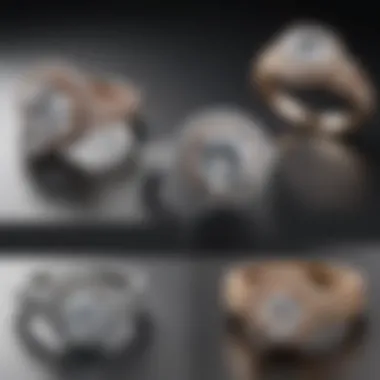
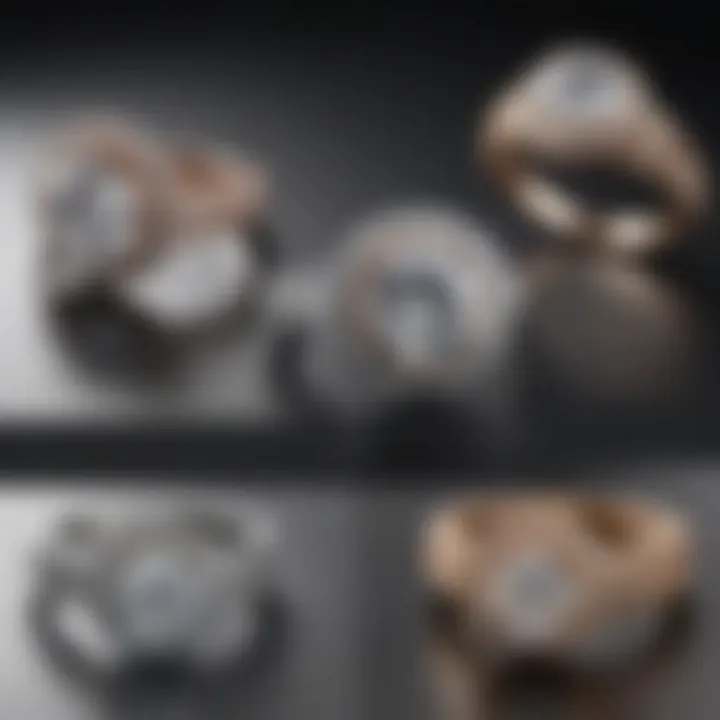
When discussing round pave engagement rings, the carat weight often garners significant attention. Carat weight measures the size of a diamond but can also influence the ring's overall aesthetic. Many pave settings tend to feature smaller diamonds, often around 0.01 to 0.15 carats each. This strategy allows for a brilliant display while sometimes making the piece more affordable compared to a single large stone.
However, one should note that the total carat weight isn't the only factor that contributes to perceived size. If multiple smaller stones are used, they can create the illusion of one larger diamond due to their combined brilliance. A careful balance is crucial. Too many small stones can overcrowd the design, while too few may not achieve the intended effect. It's all in the details, and a knowledgeable jeweler can help clients strike that perfect balance.
Color and Clarity Factors
In the realm of gemstones, color and clarity remain paramount. For round pave engagement rings, the general rule of thumb is that the diamonds should have similar color and clarity ratings. This ensures the entire ring maintains a cohesive appearance. The best color for diamonds usually ranges from D (colorless) to H (near-colorless). While color might be less discernible in smaller stones when set in a pave style, consistency across all stones helps maintain elegance.
Clarity is another vital aspect. Diamonds are evaluated based on how many inclusions or blemishes they have. Ideally, for pave settings, diamonds graded at VS1 (Very Slightly Included) or higher are recommended, as these will appear clean to the naked eye. Flaws in smaller diamonds might be less visible than in larger ones, but ensuring a high standard will deliver an exquisite end product.
Ultimately, understanding these key design elements fosters deeper appreciation for round pave engagement rings and informs potential buyers as they navigate their unique choices. Whether diving into the intricacies of pave techniques or evaluating the nuances of carat weight, color, and clarity, this knowledge empowers enthusiasts to make well-informed decisions.
Choosing the Right Ring
Choosing the right engagement ring can be a daunting task, especially when diving into the exquisite world of round pave engagement rings. An engagement ring is not just an accessory; it symbolizes love, commitment, and endless possibilities. It’s a lasting reminder that often will be worn daily, making its selection all the more significant. The intricacies involved in picking a ring extend beyond mere aesthetics. Factors such as diamond quality, the pave setting's integrity, and the overall style must come together to create a ring that resonates with the wearer’s taste. Understanding these components will not only enhance the buying experience but also ensure that the chosen ring will be cherished for a lifetime.
Tips for Selecting a Diamond
When it comes to round pave engagement rings, the diamond takes center stage. Selecting the right diamond demands a careful approach. Here are some crucial tips that may guide the decision making process:
- Understand the Four Cs: Familiarize yourself with carat weight, cut, color, and clarity. Each characteristic plays a pivotal role in the diamond’s appearance and value.
- Prioritize Cut Quality: The cut of the diamond affects how it reflects light. A well-cut diamond will dazzle brighter than others.
- Evaluate Color Intensity: Round diamonds typically shine in G-H color range, giving a balance between beauty and affordability.
- Examine Clarity: While inclusions may downgrade a diamond’s value, many are microscopic and don’t significantly impact its appearance.
- Consider Personal Preferences: Ultimately, the diamond should resonate with the wearer, incorporating their style preferences and personality into the selection.
Evaluating Pave Settings
Understanding pave settings is essential in ensuring the diamond's support and showcasing its brilliance. Pave—derived from the French word "paver"—refers to the way small diamonds are set into the band, resembling a sparkling cobblestone path. Here are key considerations:
- Quality of the Setting: Look for a secure and professional setting as it determines how well the smaller stones will be held in place. A quality setting will enhance the overall aesthetic while providing durability.
- Fit and Comfort: The band should sit comfortably on the finger. It is advisable to try various styles to find the right fit that balances comfort with design.
- Stone Size and Arrangement: The visual impact of the pave technique varies with the size and arrangement of the diamonds. A more dense setup provides an extravagant look, while a sparse arrangement feels lighter.
"A good diamond is like a good story; it keeps you coming back for more."
- Visual Harmony: Ensure that the pave setting complements the central diamond. The smaller stones should not overpower the primary diamond; rather, they should enhance its beauty.
In summary, making an informed choice while selecting a round pave engagement ring involves understanding both the diamond and the pave setting. Taking the time to weigh options will not only result in a beautiful piece of jewelry but a meaningful one that tells a story of love and commitment.
Current Trends in Round Pave Engagement Rings
In recent years, the allure of round pave engagement rings has shifted tremendously, embracing a blend of traditional craftsmanship and modern innovation. This section analyzes the driving forces behind current trends, which not only enhance the aesthetic appeal of these rings but also provide consumers with valuable options that reflect their unique tastes and values.
Emerging Styles and Innovations
One cannot discuss the current trends without mentioning the exciting new styles emerging in the world of round pave engagement rings. Designers have become bold and imaginative, experimenting with various shapes, settings, and gemstone combinations. Some notable trends include:
- Mixed Metal Bands: The use of different metals, such as rose gold combined with white gold, creates a striking contrast.
- Non-traditional Shapes: While the classic round settings are popular, there is a rise in oval or pear-shaped center stones surrounded by pave diamonds, offering a modern twist.
- Floral and Nature-Inspired Designs: Many couples are opting for rings that incorporate botanical themes, featuring delicate floral details to symbolize growth and love.
- Vintage Revival: Art Deco and Victorian styles are making a comeback, appealing to those who cherish antiques and historical nuances.
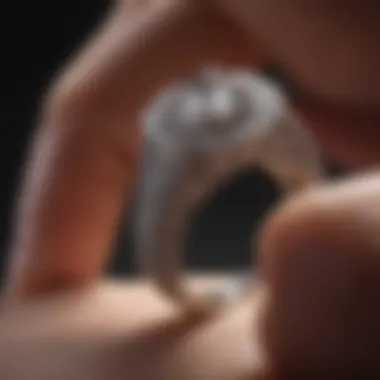
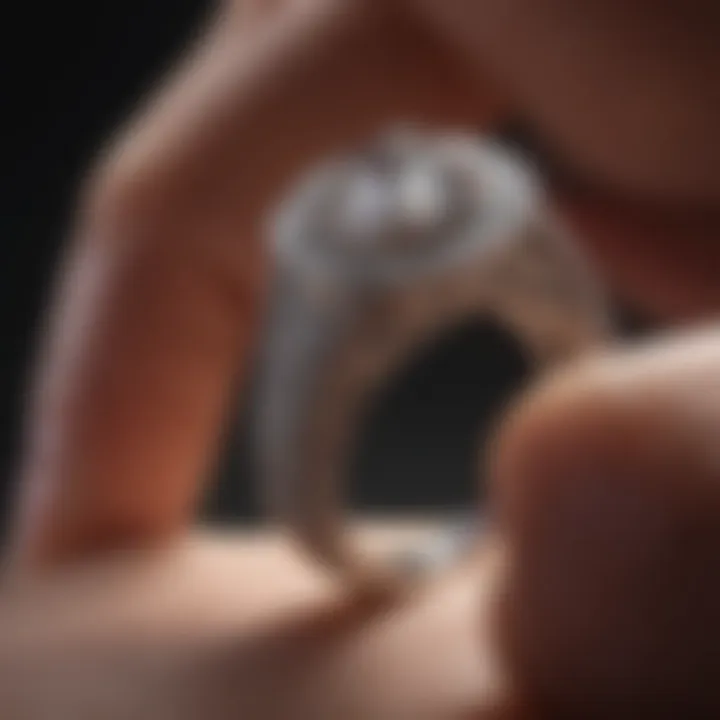
These emerging styles not only cater to changing consumer preferences but also showcase the ingenuity of jewelry designers. With each innovative design, potential buyers are encouraged to explore options that resonate with their individual stories and experiences.
Sustainable Choices in Gemstone Sourcing
Another vital aspect influencing the trends in round pave engagement rings is the growing focus on ethical and sustainable sourcing of gemstones. Many conscience-driven consumers increasingly prefer diamonds that uphold responsible mining practices which reflects a fundamental shift in buyer consciousness. Some important notes include:
- Lab-Grown Diamonds: An eco-friendlier alternative, lab-grown diamonds maintain the same physical and chemical properties as mined diamonds but are created in controlled environments at a fraction of the environmental cost.
- Conflict-Free Certification: A significant number of buyers now prioritize certified conflict-free diamonds, which assure that the stones have been ethically sourced without financing violence or human rights abuses in mining regions.
- Recycled Metals: Utilizing recycled precious metals for settings reduces the need for new mining, thus minimizing the environmental impact further.
"In today’s jewelry market, one can find stunning options that not only sparkle but also stand for ethical responsibility, making a statement far beyond mere adornment."
Individuals nowadays seek engagement rings that embody their values and morals. This consciousness ensures that the round pave engagement ring is not only a symbol of love but one that reflects a commitment to sustainability. The continued advancement in styles and ethical practices highlights the thoughtful approach that modern couples take when selecting their forever token.
With these trends shaping the landscape of round pave engagement rings, it is clear that they are more than just beautiful pieces of jewelry; they are also a manifestation of love, individuality, and ethical responsibility.
Caring for Your Round Pave Engagement Ring
Caring for your round pave engagement ring is not just about keeping it shiny; it's an essential practice that ensures its beauty and value endure over time. Given the nature of pave settings, where small diamonds are set closely together, this type of ring can be susceptible to dirt buildup and scratches. Proper care maintains not only the ring's brilliance but also its structural integrity. A little vigilance goes a long way in preserving this significant symbol of love.
Regular Maintenance Practices
To keep your pave engagement ring looking its best, establish a routine maintenance schedule. Here are several tips to consider:
- Frequent Cleaning: Regular cleaning helps to remove dust and oils that accumulate on the surface. You might mix warm water with mild soap, then use a soft brush to gently scrub the ring, especially around the pave stones. Just remember to rinse well and pat dry with a soft cloth.
- Professional Inspection: Taking your ring to a professional jeweler for an annual check-up is advisable. They can assess the integrity of the settings and ensure no stones are loose. This proactive step can prevent costly repairs later.
- Avoid Harsh Chemicals: Common household cleaners might be too strong for the delicate nature of your ring. It's wiser to avoid exposing your jewelry to solvents or abrasive agents. Stick to gentle cleaning solutions designed specifically for fine jewelry.
"A little care can make a big difference. It’s not just about cleaning; it’s about nurturing the relationship you have with that piece of art."
Storing Your Ring Safely
Proper storage is equally crucial in preserving your round pave engagement ring. Here are some guidelines to ensure your ring stays in pristine condition:
- Use a Dedicated Jewelry Box: Instead of tossing the ring into a drawer or pile with other jewelry, find a velvet-lined box with individual compartments. This helps avoid scratches from contact with other pieces.
- Keep Away from Moisture and Extreme Temperatures: When storing, choose a dry place away from humidity and drastic temperature changes. Excess moisture might encourage tarnishing or even cause stones to loosen.
- Consider Ring Holders or Soft Pouches: Additionally, while traveling or just to keep it safe at home, consider using a soft pouch or ring holder. This minimizes movements and potential damage while being stored.
- Don’t Expose to Direct Sunlight: Direct sunlight can fade certain gemstones or affect adhesives used in settings. Keeping your ring in a shaded area when not worn is a good practice.
Implementing these care practices will help ensure that your round pave engagement ring continues to sparkle and shine, year after year. Not only does this prolong the life and beauty of your ring, but it also maintains the sentimental value that comes with it.
End
The examination of round pave engagement rings reveals a multifaceted appeal that resonates deeply with a variety of audiences, from gemstone enthusiasts to jewelry designers. These rings are not merely ornamental; they symbolize commitment and love while showcasing a remarkable blend of artistry and craftsmanship.
The Lasting Appeal of Round Pave Rings
The round pave ring stands out for several reasons.
- Visual Impact: The setting creates a stunning light-play effect, enhancing the diamond's brilliance. The pave technique, where multiple tiny diamonds are set closely together, allows the center stone to shine even brighter, pulling attention and admiration. This effect can make even modestly sized stones appear larger than life.
- Design Versatility: One of the most attractive features of round pave rings is their adaptability. They can be crafted in various styles, from classic elegance to modern aesthetics. Whether set in platinum or yellow gold, the style can complement any personal taste or occasion.
- Symbolism and Sentiment: Beyond their beauty, round pave rings carry significant emotional weight. Their intricate designs can represent the complexity and multifaceted nature of love itself. It’s not uncommon for couples to choose these rings for their wedding or engagement because they encapsulate heartfelt stories and shared experiences.
"A pave engagement ring reflects love’s brilliance; it shines even brighter when paired with meaningful choices."
- Craftsmanship: The skill involved in creating these rings is impressive. Jewelers must meticulously place each tiny diamond, often using a specialized technique to ensure they fit snugly into the shank. This level of craftsmanship adds value in both monetary and sentimental terms, making these rings cherished pieces that can be handed down through generations.
In summary, the lasting appeal of round pave engagement rings stems from their unique blend of visual allure, craftsmanship, versatility, and emotional significance. As you contemplate the choice of such a ring, remember it’s not just a piece of jewelry; it's a reflection of one’s personal journey and a testament to lifelong commitments.







